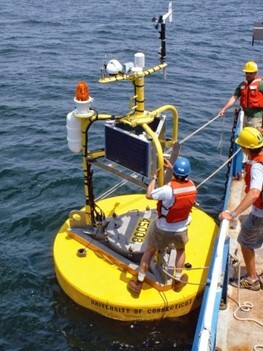Long Island Nitrogen Action Plan (LINAP)- Newsletter
The New York State Department of Environmental Conservation sent this bulletin on 08/21/2023 10:28 AM EDT |
| DEC Delivers - Information to keep you connected and informed from the NYS Department of Environmental Conservation |
Long Island Nitrogen Action Plan (LINAP) - Newsletter
|
|
Water Quality Monitoring Programs The Long Island Sound Study (LISS) is involved in several water quality monitoring programs to gather valuable data to better understand and manage the estuary's conditions. These programs include ship-based monitoring, real-time buoy monitoring, citizen science through the Unified Waters Study (UWS), and collaboration with the United States Geological Survey (USGS) for stream and river monitoring. Ship-based monitoring, in partnership with local agencies, tracks parameters like temperature, salinity, and nutrient levels. The Long Island Sound Integrated Coastal Observing System (LISICOS) utilizes buoys for continuous real-time sampling, filling gaps between ship-based surveys. The UWS involves volunteers monitoring various locations, contributing to assessing human impact and ecosystem health. USGS examines water quality in connecting water bodies, aided by LISS grants, crucial for understanding pollutant inputs and climate-related changes. These programs collectively enhance Long Island Sound's environmental insights and management efforts.
Deploying a monitoring buoy in the Western Sound. Photo Credit: LISICOS. Click here for more information on each of these programs. Monitoring for Coastal Acidification Coastal acidification is a growing problem and is linked to excess nitrogen. When the water becomes more acidic, shell-forming animals (e.g., coral, shellfish) struggle to properly form their shells, which impairs their development and ultimately their survival. The Long Island Sound Study has initiated a long-term effort to monitor coastal acidification. As part of this effort, several projects have been launched to deepen our understanding of coastal acidification in the Sound. For instance, the Connecticut Department of Energy and Environmental Protection (CT DEEP) Monthly Water Quality Sampling Project is adjusting its ongoing monitoring activities to include measurements related to coastal acidification. By doing so, researchers aim to better grasp how acidification impacts offshore waters over extended periods and its connections to eutrophication, hypoxia, and climate change. Additionally, the Interstate Environmental Commission is expanding their monitoring efforts in the western Sound to complement those of CT DEEP. Their joint assessments provide a comprehensive view of water quality factors linked to hypoxia throughout the Sound. The United States Geological Survey (USGS) is playing a crucial role as well, creating a lasting monitoring network to enhance the observation of embayments across the Long Island Sound. By gathering essential data, this initiative helps calculate aragonite saturation, a key marker in tracking ocean acidification. As ocean water becomes less saturated with aragonite, a mineral needed for the formation of marine organisms' shells, it becomes harder for corals and mollusks to build and maintain their protective coverings. By examining aragonite saturation, scientists can better understand how ocean acidification affects these organisms and their survival. Other projects, such as Save the Sound's Long Island Sound Embayments Project and UCONN's Real-Time Monitoring Network, contribute by involving community science groups and using advanced technology to monitor changes in the water, ultimately contributing to the preservation of the Long Island Sound ecosystem. Long Island Sound Study's Habitat Restoration Initiative Tidal wetlands are among the most critical habitats on Long Island. Marsh grasses grow in wetlands and provide food, shelter, and breeding grounds for many species of wildlife. It also protects the land from flooding and erosion, and filters pollutants like nitrogen contained in stormwater runoff. Today, there are about 21,000 acres of tidal wetlands along the Sound’s shoreline. About 25 to 35 percent of the Sound’s tidal wetlands were lost before laws protecting them were enacted in the early 1970s. Despite protection and restoration efforts, marsh grasses are still disappearing. Possible contributing factors include sea-level rise, insufficient sediment, erosion, and the indirect effect of local dredging. Research also suggests that nutrients from lawn fertilizer and septic tanks play a role in the deterioration of marshes. This year, LISS will work to restore Flax Pond in Old Field, NY. The Stony Brook University School of Marine and Atmospheric Sciences studied Flax Pond and determined that the inlet must be returned to its 1972 dimensions to restore its health. The project consultant will design and implement a project to remove sediment from the inlet to restore tidal flushing and reduce possible hypoxic events. This is expected to improve the tidal wetland health and restore it to its 1972 condition. Last year’s efforts by the program led to a total of 86 acres of tidal wetlands being restored, the highest year of growth since 2012. A total of 1,157 acres have been restored since the program’s inception in 1998! Grant Opportunity – US Army Corps Pilot Program Water Resources Projects for Small or Disadvantaged Communities The U.S. Army Corps of Engineers is launching a pilot program to fully fund small water resources projects for economically disadvantaged communities (based on the federal definition of disadvantaged communities (PDF)). This program was directed by Section 165 of the Water Resources Development Act (WRDA) of 2020. The deadline was extended and project proposals are now due by October 20, 2023. Find information on how to apply, a fact sheet, a template letter of intent, and program requirements on the WRDA 2020 website. To sign up for the LINAP newsletter, visit our webpage or click here. |

